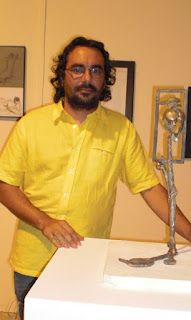
Ulysses
Felt-tip pen on paper, 42x29,7 cm.
Cover of the Literary Journal n. 49
La Solana, January 2006
Literary and Artistic Association `Pan de Trigo´
I thank Mr. Jesús Martínez Mira for allowing me to use his poem in my blog.
ULISES (Poem)
La noche es aún más noche,
más túnel de fantasmas en acecho,
desde que duermo sola.
He cubierto mis hombros con un chal de penumbra
y, descalza, he salido al balcón de las ausencias
porque aquí te recuerdo
mirando el ancho mar salpicado de gaviotas
en cada amanecer de luz y fuego.
Es el mismo balcón en que esperaba
tu vuelta, años atrás, cuando te hervía
la sangre joven y marchabas lejos,
a tu reino de fiebre y de placer,
tras el placer calmante de tu fiebre,
dejando en el espejo del pasillo
solamente una sombra difusa de tu imagen.
Te fuiste muchas veces y otras tantas
regresaste a mi lado: las paredes
festejaban tu voz
y yo jamás lanzaba los dardos del reproche.
En profundo silencio, me sentaba
a la orilla derecha de la luna
y tú, sobre mis muslos, desmayabas,
en silencio profundo, tu cansancio.
Rasgándole a la noche sus ángulos oscuros,
yo te daba cobijo
y pasaba mi mano por tu cuerpo
porque era la manera más segura
de sentirte de nuevo compartiendo
soledades conmigo
y de ahuyentarme el miedo
a perderte otra vez por las esquinas
de tus caprichos.
Poco a poco, el herrero de los años
fue forjando eslabones de hierro bien fundido
con los que encadenarte a este paisaje
de nuestras vidas
amasadas de amor y nostalgias.
Accediste y dejaste tu promesa
sobre el violeta vivo de mi falda,
y, de ahí en adelante, día y noche,
cada minuto,
permanecimos juntos.
Dormimos siembre bajo el mismo techo
y encima siempre de las mismas sábanas.
Compartimos los sueños imposibles
y la quieta impaciencia del insomnio.
Desde el sofá con flores mil veces escuchamos
la magia de Strawinsky
y otras mil veces vimos Casablanca.
Si en el punto de cruz me sumergía,
tú mirabas absorto la danza de la aguja
por la intrincada red del cañamazo
y, si tú meditabas en silencio,
yo, para no interrumpir tu paz, me zambullía
en las tranquilas aguas de tus ojos.
Recorrimos otoños, primaveras,
inviernos y veranos como estrellas
fugaces que dibujan
cuadros abstractos sobre oscuro lienzo.
Todo estaba perfecto, pero todo
saltó hecho añicos
igual que saltan
los trozos de cristal de cualquier copa
que, por descuido, se nos cae al suelo.
Me faltas otra vez y, ahora, me faltas
desde el último junio,
y estoy tan arrimada a la tristeza,
al dolor y a las lágrimas
porque sé que no tengo ya esperanza,
que ya no has de volver
ni siquiera quebrado como un gozne
que la humedad del alba haya oxidado.
Yo, para esto, no estaba preparada
y, aunque no lo supieras, es posible
que tú tampoco lo estuvieras para
vivir siempre a mi lado
restaurando presencias que, a veces, me quitaste.
¿Cómo, si no, se entiende tu partida?
¿Quién te otorgó licencia, dime, para matarte?
¿Por qué me hiciste
ver tu cuerpo estrellado en el asfalto,
Ulises, viejo amigo, viejo gato?
First Prize `Pedro Alonso Morgado´, 2005
La Palma del Condado, Huelva.
Jesús Martínez Mira from Castellón-Benicasim (Castellón)

.jpg)





























































